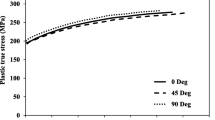Abstract
Numerical simulation of stretch flange forming of Al–Mg sheet AA5182 was performed using the upper and lower bound constitutive models of Gurson–Tvergaard–Needleman (GTN) and Sun and Wang, respectively. Stress and strain-controlled nucleation rules are adopted for both models. The lower bound model of Sun and Wang has been extended to include the void coalescence criterion of Tvergaard and Needleman to form the so-called Sun–Tvergaard–Needleman (STN) model. Upper and lower bound formability predictions are combined to create a predictive formability band as actual formability lies between these limits. The resulting formability predictions are compared with experimental results and an appropriate void nucleation stress and strain suggested.
Similar content being viewed by others
References
Chein WY, Pan J, Tang SC (2001) Modified anisotropic Gurson yield criterion for porous ductile sheet metals. J Eng Mater Technol 132:409–416
Chen ZT (2004) The role of heterogeneous particle distribution in the prediction of ductile fracture. Ph.D. Thesis, University of Waterloo, Canada
Chen ZT, Worswick MJ, Pilkey AK, Lloyd DJ (2005) Damage percolation during stretch flange forming of aluminum sheet. J Mech Phys Solids 53:2692–2717
Chen ZT, Worswick MJ, Lloyd DJ (2006) Damage-based finite element modeling of stretch flange forming of aluminum-magnesium alloy. Mater Sci Forum 519–521:815–820
Chu CC, Needleman A (1980) Void nucleation effects in biaxially stretched sheets. J Eng Mater Technol 102:249–256
Cinotti N (2003) Stretch flange formability of aluminum alloy. Master Thesis, University of Waterloo, Canada
Francescato P, Pastor J, Riveill-Reydet B (2004) Ductile failure of cylindrically porous materials. Part I – plane stress problem and experimental results. Eur J Mech Solids 23:181–190
Gurson AL (1977) Continuum theory of ductile rupture by void nucleation and growth – Part I. Yield criteria and flow rules for porous ductile media. J Eng Mater Technol 99:2–15
Leblond JB, Perrin G, Devaux J (1994) Bifurcation effects in ductile metals with damage delocalization. J Appl Mech 61:236–242
Liao KC, Pan J, Tang SC (1997) Approximate yield criteria for anisotropic porous ductile sheet metals. Mech Mater 26:213–226
Lievers WB, Pilkey AK, Lloyd DJ (2003) The influence of iron content on the bendability of AA6111 sheet. Mater Sci Eng A 361:312–320
Lievers WB, Pilkey AK, Lloyd DJ (2004) Using incremental forming to calibrate a void nucleation model for automotive aluminum sheet alloys. Acta Mater 52: 3001–3007
Needleman A (1987) Continuum model for void nucleation by inclusion debonding. J Appl Mech 54:525–531
Pardoen T, Hutchinson JW (2000) An extended model for void growth and coalescence. J Mech Phys Solids 48:2567–2512
Reusch F, Svendsen B, Klingbeil D (2003) Local and non-local Gurson-based ductile damage and failure modeling at large deformation. Eur J Mech Solids 22:779–792
Richmond O, Smelser RE (1985) Alcoa Technical Center Memorandum
Saje M, Pan J, Needleman A (1982) Void nucleation effects on shear localization in porous plastic solids. Int J Fract 19:163–182
Shabrov MN, Needleman A (2002) An analysis of inclusion morphology effects on void nucleation. Model Simul Mater Sci Eng 10:163–183
Shima S, Oyane M (1976) Plasticity theory for porous metals. Int J Mech Sci 18:285–291
Sun Y (1995a) Influence of void nucleation and growth on deformation localization in tensile sheet specimen. Eng Fract Mech 51:381–395
Sun Y (1995b) Constitutive equations for ductile materials containing large and small voids. Mech Mater 19:119–127
Sun Y, Wang D (1989) A lower bound approach to the yield loci of porous materials. Acta Mech Sin 5:237–243
Sun Y, Wang D (1995) Analysis of shear localization in porous materials based on a lower bound approach. Int J Fract 71:71–83
Thomason PF (1990) Ductile fracture of metals. Pergamon Press Inc., Oxford
Tszeng TC (2000) Interfacial stresses and void nucleation in discontinuously reinforced composites. J Eng Mater Technol 122:86–92
Tvergaard V (1981) Influence of voids on shear band instabilities under plane strain conditions. Int J Fract 17:389–407
Tvergaard V (1982) Ductile fracture by cavity nucleation between larger voids. J Mech Phys Solids 30:265–286
Tvergaard V, Needleman A (1984) Analysis of the cup-cone fracture in a round tensile test bar. Acta Metall 32:157–169
Tvergaard V, Needleman A (1995) Effects of non-local in porous plastic solids. Int J Solids Struct 8:1063–1077
Wang DA, Pan J, Liu SD (2004) An anisotropic yield criterion for porous ductile sheet metals with planar anisotropy. Int J Damage Mech 13:7–33
Wen J, Huang Y, Hwang KC, Liu C, Li M (2005) The modified Gurson model accounting for the void size effect. Int J Plast 21:381–395
Worswick MJ, Pelletier P (1998) Numerical simulation of ductile fracture during high strain rate deformation. Eur Phys J Appl Phys 4:257–267
Yan XQ (1992) Effect of yield surface curvature on local necking in biaxially stretched sheets in porous materials. J Eng Mater Technol 114:196–200
Author information
Authors and Affiliations
Corresponding author
Rights and permissions
About this article
Cite this article
Butcher, C., Chen, Z. & Worswick, M. A lower bound damage-based finite element simulation of stretch flange forming of Al–Mg alloys. Int J Fract 142, 289–298 (2006). https://doi.org/10.1007/s10704-006-9044-3
Received:
Accepted:
Published:
Issue Date:
DOI: https://doi.org/10.1007/s10704-006-9044-3




